
Is there a wine more celebratory than Rosé?
I suppose you could argue Champagne and sparkling wines wear that crown. But after the winter from hell that we’ve all collectively endured, I’d argue nothing signifies hope, patios and the promise of sunnier days ahead quite like pink wine.
Rosé’s days as a lightweight ‘contenda’ – the wine no one takes seriously – are definitely behind us.
Rosé today is responsible for 10% of international wine sales with global growth pegged at +40% (2002 to 2018 – CIVP). The catalyst for change and the source of all this growth? Provence rosé, eh.
The first thing most Instagram-savvy wine lovers say when presented with a palette of pink rosé is “isn’t that pretty”, says Elizabeth Gaby, Master of Wine and author of the book Rosé: Understanding the Pink Wine Revolution. “There’s a huge bias towards Provence-style, pale colour rosé” she exclaims. Whether it’s blush, coral, peach, onion-skin, salmon, magenta or fuchsia, pink wine is almost always judged principally by its pigment.
Look no further than Whispering Angel and the wines of Chateau d’Esclans in Provence for a lesson in pink identity marketing. The (sub-conscious) emotional investment and connective tissue linking pale pink wine with prestige, sophistication and self-esteem, is worthy of a master’s thesis.
And yet, and yet…..if people taste a darker rosé wine with more fruit and more extract, they usually like it too, sighs Gaby. For now, demand for pale pink pours has grown from 50% of the world market (2013) to 70% (2018) providing a remarkable commentary on the power of marketing and the psychology of colour.
But there are so many more colours in the rosé rainbow….

Niagara Rosé: Beyond the Pale
The really cool thing about Niagara is the apparent willingness of rosé winemakers to take risks and do right by the terroir.
Yes, Niagara has its share of seriously tasty pale pink rosé – what’s known the world over as Provençal style rosé. I may even have a bottle or 20 in my cellar (aka basement)!
But this summer, many winemakers are also experimenting with a rainbow of rosés and a range of grape varieties to give wine lovers a diverse and FUN selection of rosé flavours and drinking occasions (aperitif vs meal pairing).
The other exceedingly cool thing about Niagara Peninsula rosé? The natural acidity. In some parts of the world, producers are forced to pick early to achieve that hit of acidity. In Niagara, crisp, bright rosé is a given. Cool lake breezes and what’s called the ‘diurnal shift’ – hot days and cool nights – combined with long days of Ontario sunshine, create ripe flavours and lean, racy acidity, viticultural pre-requisites for fresh delicious rosé.

A Quick Rosé Primer
I’ve got 10 delicious #local Niagara wines for rosé enthusiasts to enjoy, representing a yummy spectrum of varietals, styles and PINK! Why not pick up a few and enjoy these rosé wines at home?
I hosted a socially distanced night of ‘rosé in the round’ (a drinking circle) and my double-vaxxed (yay!) neighbours gained a huge appreciation for the range of style options and producers in the Niagara region.
Before we dive into these pink wines, here’s a quick rosé primer (NOTE – if you know everything there is to know about rosé – scroll down to the wines):
Rosé Production Styles and Methods
Rosé may sit on the red pigment colour spectrum (hence rosé, rosato, rosado) but the original French appellations (AOP/AOC) and regions around the world often blend a mix of red and white varieties to produce rosé. As with red and white wine, grape varieties have unique aroma and flavour attributes and inevitably reflect the geographical character of the region.
Famous French rosé appellations include Tavel in the southern Rhone region where grenache and cinsault are the key varieties in the blend. Further south in the Bandol region of Provence, Mourvèdre is the grape of choice, providing more tannic structure and darker concentrated fruit. In Provence and further west along the Mediterranean in the Languedoc, a blend of southern Rhone grapes are employed, the most popular include Grenache, Syrah, Mourvèdre, Cinsault and Carignan.
In Niagara, terroir dictates varietal selection. Up on the Niagara Escarpment, the fossil-rich soils, limestone bedrock and higher elevation contribute distinctive mineral profiles to the wines. The microclimates of the cascading, lower terraced benchlands that eventually make their way to the shores of Lake Ontario, all express their own unique character. The best varietals for rosé here? Juicy Cab Franc, Gamay and Pinot Noir all produce crisp, vibrant wines bottled varietally or in yummy blends.
Stretching along the shore of Lake Ontario in the Niagara-on-the-Lake regional appellation are four sub-appellations that benefit from warmer days and cool lake breezes. Proximity to the lake results in a broader selection of grapes including Bordeaux varietals, profiled beautifully in the rosés made in this region.
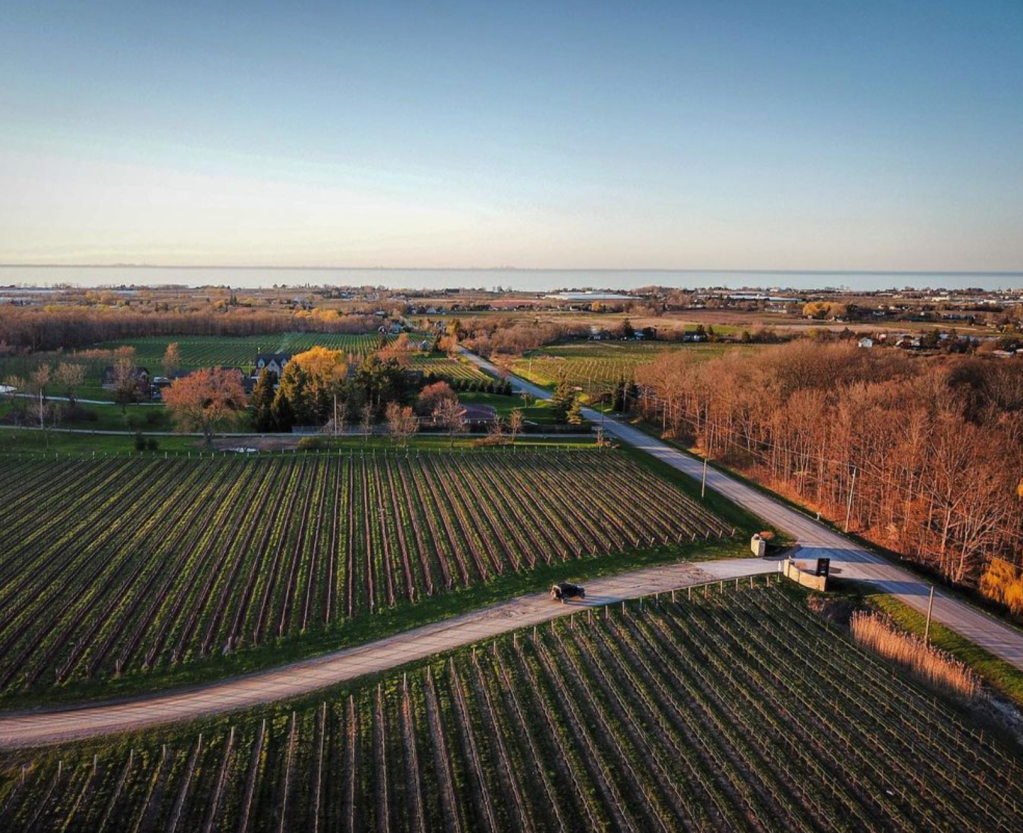

Rosé Methods
Worthy of a book, here’s a few fast facts on the rosé winemaking methods that contribute to the aromas, flavours and textures in your glass.
Saignée method – is favoured by purists looking for the depth and complexity of reds but in a lighter, easier drinking format. Saignée involves “bleeding” off early juice from the red-winemaking process before the wine becomes too concentrated. Saignée rosés have deeper hues, more fruit, more extract, and in some cases a more complex range of flavours. Critics say it’s a ‘by-product’ of red winemaking vs ‘the main event’.
Direct-to-Press – Of course, many wine makers argue the direct press method offers a more refreshing, lighter wine that’s truer to the origin story of rosé. With this method, the winemaker has complete control over grape sugars and acid levels at harvest.
At the vinification stage, they can similarly manage the maceration schedule – essentially, the length of time the juice is in contact with the skins. With red wines, that contact happens right through to the end of fermentation. With rosé, however, the process is abbreviated with skin contact lasting hours or at most, a couple of days – depending on the desired pigment concentration.
Worth noting, rosé wines, like white wines, are fermented at cooler temperatures to help retain their freshness and light profile.
Two other rosé methods worth noting:
Blush – Is the process of blending red sparkling with white sparkling wines. This is done exclusively with sparklers (per French appellation laws) and never with still wines….. we hope!
Vin Gris – This method is used to produce light colored rosés with just a hint of pink. We’re talking mere minutes of maceration time, producing a rosé with subtler fruit tones, but that’s also clear, precise and light-bodied.
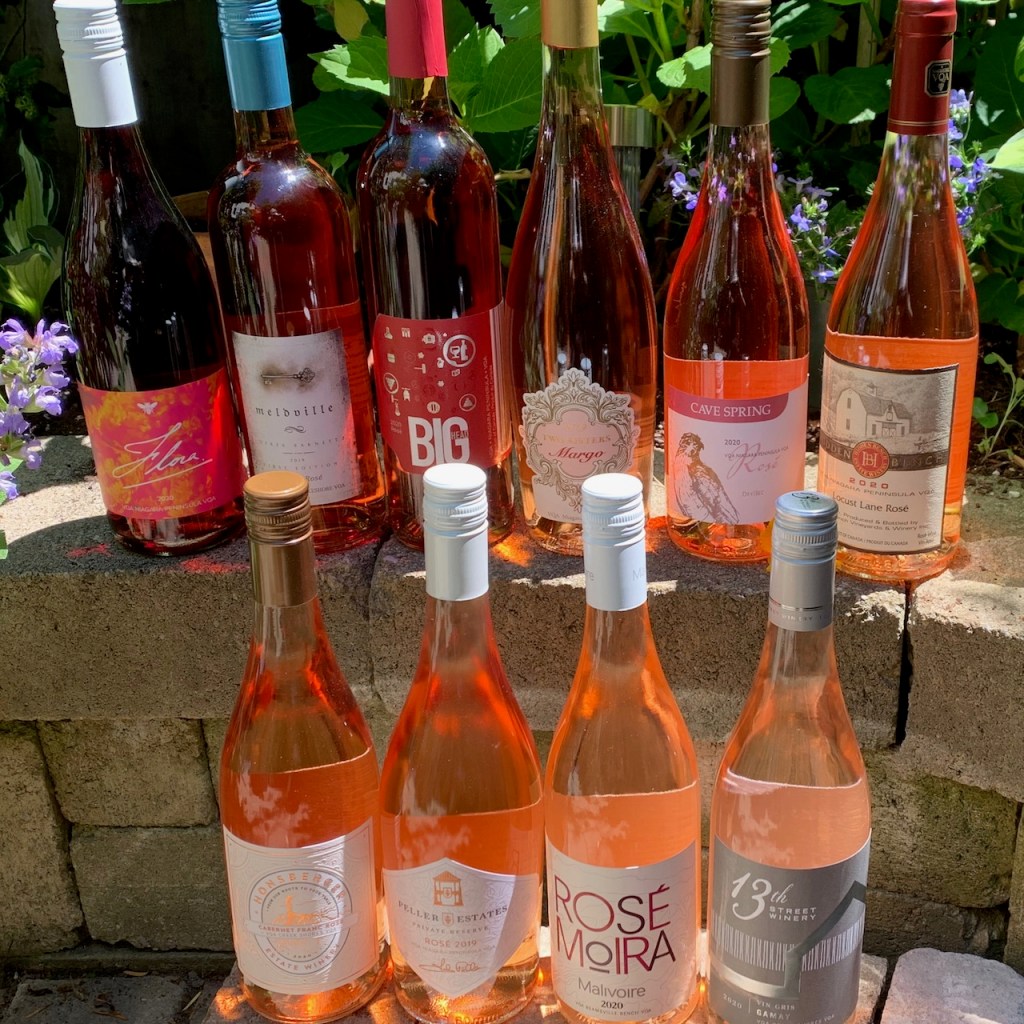
Exploring Local Niagara Rosé
There’s a lot of delicious rosé in our own backyard (and now in my backyard 🙂
Niagara winemakers are showing creativity and flair producing wines with ripe concentrated flavours, amazing acidity, and in many cases with lower alcohol (Brangelina’s Provençal rosé Chateau Miraval has 14%…. just sayin’). In the cellar, we’re seeing amphora, indigenous yeasts, and some bold imaginative winemaking.
Here’s a few Niagara Rosés to consider as you #supportlocal….. #buylocal !!

Malivoire Rosé Moira – 2020 – VQA Beamsville Bench $25 – 12.5% ABV – Certified Sustainable, Vegan-friendly
100% Pinot Noir – 0 g/L RS
Malivoire is one of the original and esteemed pioneers of the Beamsville appellation with its trademark, cool-climate and limestone-inspired French varietals.
A Provence-style pale pink stunner, this beautifully scented Pinot Noir Rosé has inviting cherry, peach and jasmine summer aromatics. Very dry with medium-bodied weight and crisp acidity. Fruit abounds with familiar Pinot flavours of cranberry and sweet harvest cherries and a pink grapefruit note. Beautifully balanced with a long rewarding patio finish.

Two Sisters Rosé – 2019 – VQA Niagara River – $35 – 13% ABV
70% Merlot, 19% Cab Franc, 11% Cabernet Sauvignon – 3 g/L RS
From the superb 2019 vintage, and one of the few Bordeaux blend rosés in Niagara, the Margo is another direct-to-press rosé showing very little skin contact. The resulting wine is a delicate, pale pink hue, which – together with the elegant bottle presentation – makes it dreamily reminiscent of Mediterranean and specifically Provence inspired rosé.
Of course, Two Sisters offers the crème de la crème Niagara hospitality experience, with estate grown fruit, award-winning wines, and a restaurant and patio food and wine pairings that truly excel.
On the nose, this plush merlot offers strawberry, blueberry, honey-dew melon and peach. Layers of ripe berry flavours and damson plum follows on the palate, punctuated by earthy, herbal notes. Dry (3g/L), richly textured with substantial acidity and mouthfeel proving pale wine can be deliciously complex.
The lovely balance makes this crisp, refreshing rosé perfect for summer sips. Serve with poached salmon and dill or pan-seared scallops.
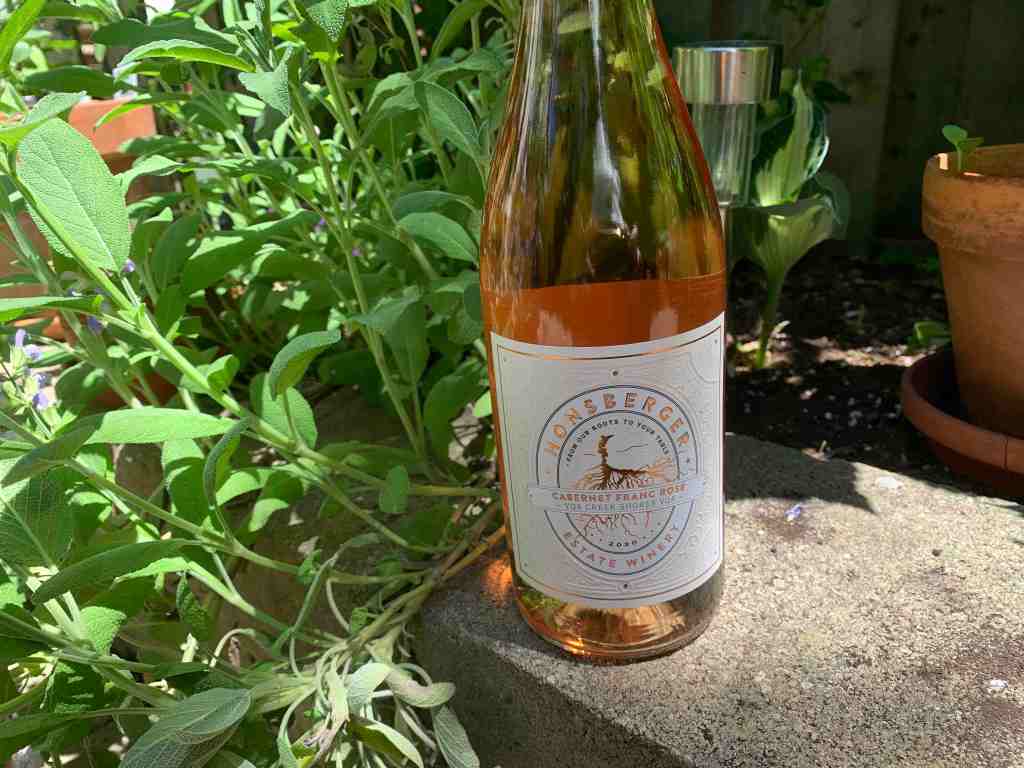
Honsberger Rosé – 2020 – VQA Creek Shores – $24 – 12.5% ABV
100% Cab Franc – 10 g/L RS
This is the third vintage of Honsberger Rosé I’ve enjoyed from the incredibly beautiful, 11½ acre Honsberger estate in the Creek Shores appellation. Gotta say – the wines here are utterly delish and the hospitality, deliciously inviting.
There’s an inherent glamour to Honsberger’s delicate pale pink rosé, but don’t be thinking it’s style over substance. Winemaker Kelly Mason coaxes a lot of earthy terroir and Cab Franc varietal character out of this rosé wine.
Complex and expressive, the wine displays a strawberry, cherry, cotton candy and lilac nose with earthy, herbal elements. The palate is juicy, decidedly dry (considering the 10 g/L RS) and loaded with fresh berry fruit. Trademark Niagara minerality and crisp acidity ensure a clean, long textured finish. I suggest you enjoy this rosé on the lovely Honsberger patio with a Margarita pizza while watching the llamas, goats and sheep frolic in the meadow.
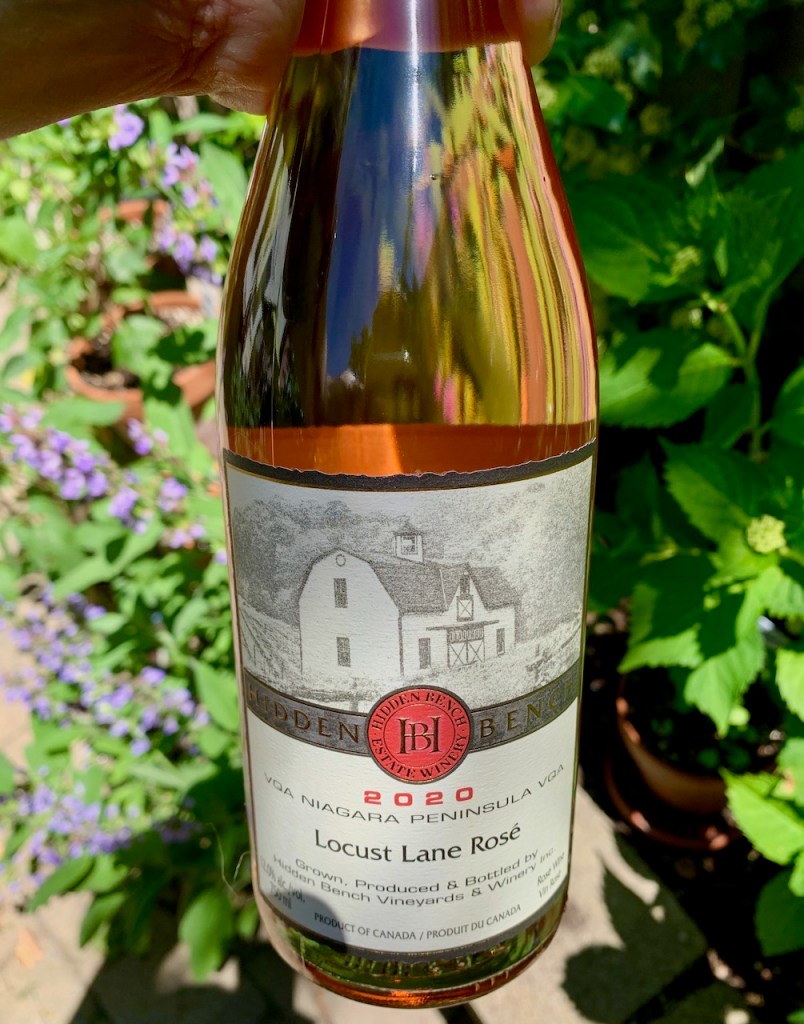
Hidden Bench Rosé – 2020 – VQA Niagara Peninsula $24.75 – 12% ABV – Certified Organic, Vegan Friendly
95% Pinot Noir, 5% Viognier – 3.2 g/L Residual Sugar (RS)
The folks at Hidden Bench know how to make really elegant and fresh rosé and the 2020 is no exception. Pale salmon, the Locust Lane Rosé combines both ‘direct to press’ and ‘saignée’ methods to create a truly delicate, fruit-forward blend. Whole-cluster pressed Pinot Noir is blended with a small addition of perfumed, viscous Viognier, which adds discernable weight and richness.
Floral and fresh fruit aromas include rose garden, citrus blossom and newly picked summer berries. The palate is all that and more with light notes of cherry, raspberry and fresh pineapple. Earthy minerality reminds you you’re in the Niagara benchlands. Dry and refreshing, with lovely balance and texture.

Peller Estates – Private Reserve Rosé 2019 – VQA Niagara Peninsula – $22.95 – 12% ABV
90% Pinot Noir, 8% Gamay, 2% Pinot Meunier – 4.9 g/L RS
From Peller Estates, one of the most beautiful properties in Niagara, an equally elegant and delicate coral pink Rosé made by the direct to press traditional skin contact method.
This Pinot-dominant blend features a fruit-forward nose with bright cherry, strawberry and watermelon. The palate is fruity, light and dry (4.9g/L) with pear, a hint of tropical pineapple and delicate strawberry fruit. A twist of grapefruit on the finish adds a slight bitter note with yummy flinty Niagara minerality.
Bright, fresh acidity balances the hint of sweetness. Pair this pretty wine with grilled fish, grilled chicken or afternoon charcuterie.
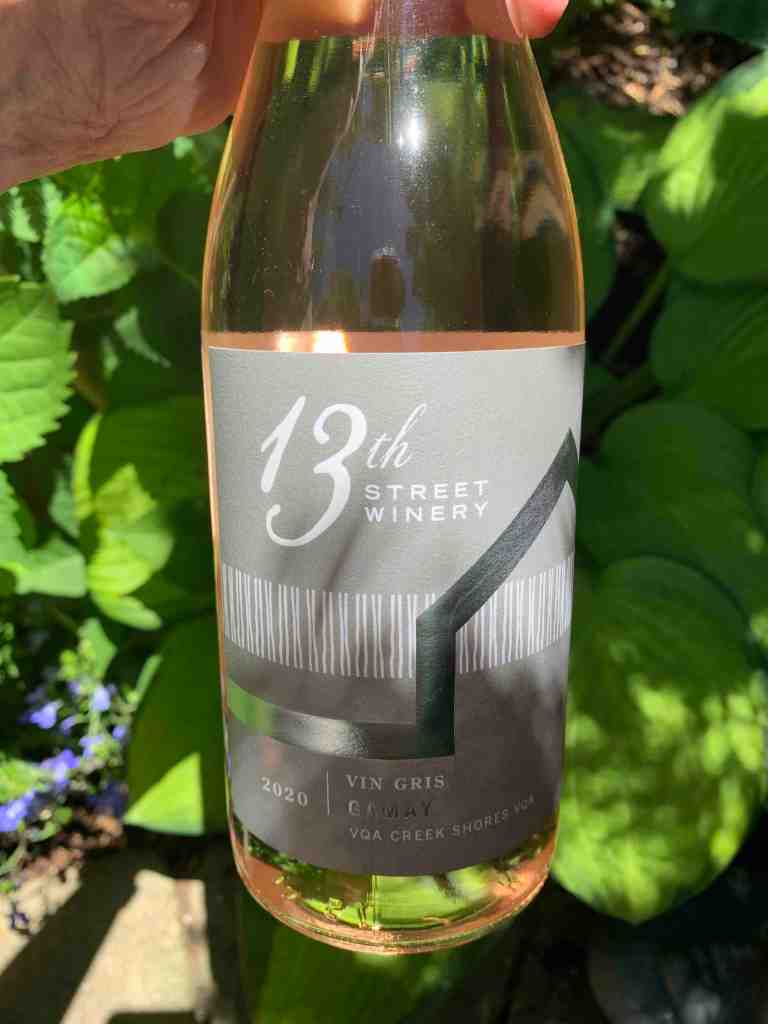
13th Street Gamay Vin Gris 2020 – VQA Creek Shores – $24.95 – 12% ABV – Certified Sustainable – Vegan friendly
100% Gamay – 3 g/L RS
Who doesn’t love discovering an exciting, French-inspired rad wine-making technique on the ‘skin tone’ end of the rosé pink spectrum? (You can put your hands down now.)
Inspired by the vineyards in Côtes de Toul, an appellation in north-eastern France that uses Gamay (principally) to make a pink-tinged Vin Gris rosé, 13th Street’s French winemaker Jean-Pierre (JP) Colas has introduced a vibrant, citrus VG rosé to the busy 13th St rosé portfolio.
The “Vin Gris” method borrows from classic white grape, wine-making techniques. Essentially, the harvest team brings in the grapes and into the wine press they go with little to no skin contact or maceration. In the case of Vin Gris, it’s red grapes that are fed into the press, resulting in juice with just a hint of pink (don’t get the grey descriptor, but….).
Floral aromas abound in this Vin Gris, with bin apple, strawberry fields and thyme playing supporting roles. On the palate, bright grapefruit citrus, with pear, strawberry and peach flavours punching through. Peppery, zippy acidity and loads of stony minerality lend vibrance to a long finish. Pair with a patio, baguette and some delicious, creamy sheep’s cheeses.

Cave Spring Rosé – 2020 – VQA Niagara Peninsula – $14.95 – 13.0% ABV – Certified Sustainable, Vegan-friendly
100% Cab Franc – 2 g/L RS
From Niagara’s esteemed and award-winning ‘House of Riesling’, Cave Spring Vineyard also consistently delivers superb Cab Franc reds and Cab Franc-inspired rosé at fantastic value.
A beautiful salmon pink – or rose gold, if you will – this fragrant Beamsville Bench rosé offers a bouquet of wild rose, strawberry and herb de Provence aromas. Crisp, dry (2g/L RS) and medium-bodied with flavours of bright cherry, strawberry, Honeycrisp apple and distinct herbal undertones (best appreciated if your rosé isn’t overly chilled). Balanced acidity with a fresh, palate cleansing finish.
This rosé is further evidence of Cave Spring’s resolve to ‘dry-up’ their portfolio of wines, and make them even more food-friendly. Enjoy with an asparagus risotto and spicy tahini green salad. I did!!

Big Head Rosé – 2020 – VQA Niagara Peninsula – $25 – 10% ABV
90% Malbec, 10% Big Head White Blend – 2 g/L RS
The legions of fans who enjoy Big Head’s famously BIG red wines are probably enroute Niagara – as I type – to snag one or two of these limited edition, fuller-flavoured malbec rosés.
Winemaker Andrzej Lipinski has been perfecting his bigger is better artform in the Niagara region since 1989, when he moved from Poland to the Niagara Peninsula. Andrzej worked at many of Niagara’s marquee wineries including Vineland Estate, Foreign Affair, Organized Crime, Burning Kiln and Colaneri before launching Big Head in 2013. His meticulous dedication to his craft and famed appassimento style reds, have attracted a significant international following.
When I ask about the winemaking method used for this rosé, Andrzej’s son Jakub Lipinski laughs: “my dad would only make rosé using the saignée method.” For a guy whose promise of big wines is baked into the name, I suppose that makes infinite sense.
This is a seriously delicious and elegant wine with trademark Malbec juiciness and crisp ripe flavours. It’s concentrated, perfumed and aromatically enticing with notes of raspberry, strawberry and rhubarb pie. Mineral, of course, and dry.
What stands out for me is the tremendously silky texture, a lovely gift imparted from five months of lees aging in clay amphorae.
For a family winery focused on big, charismatic wines, this rosé is actually delightfully light-bodied with only 10% alcohol (hurray!!!) making it a fabulous option for patio lunches and rosé all day.
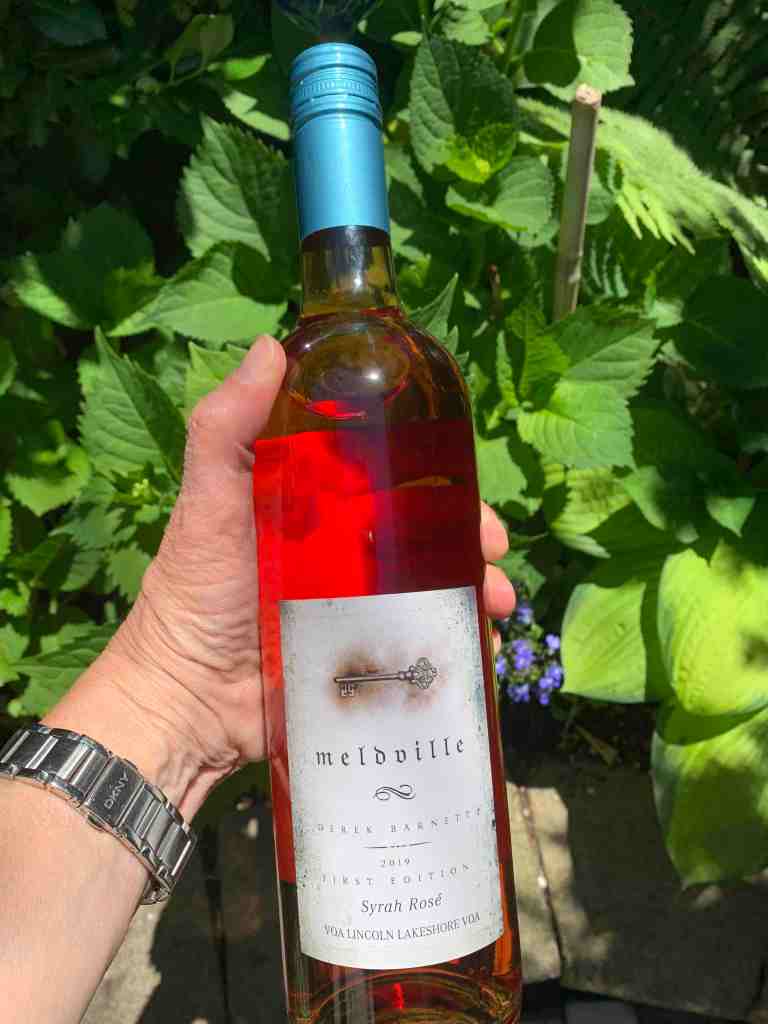
Meldville Syrah Rosé – 2019 – VQA Lincoln Lakeshore – $20 – 12% ABV. Note – wines are available online or at Legends Estate Winery
100% Syrah
Oh my. How much do I love this wine? Deliciously earthy, funky, barnyardy and savoury with extreme meaty and iron aromatics. And all this in a rosé!!!
Winemaker Derek Barnett has made his mark in Ontario crafting low intervention wines at Southbrook Vineyards (9 years), Lailey (15 years) and more recently, at Karlo Estates in Prince Edward County. In 2017, Barnett – who has been called one of the most important winemakers in Ontario – launched his own small batch, limited edition virtual winery called Meldville Wines, a nod to his English, Leicestershire roots.
The Meldville 2019 Syrah Rosé (First Edition) is true to Syrah’s varietal profile and its Northern Rhone roots. Another rosé on the dark end of the pink spectrum, it offers up a complex, vibrant nose of cranberry, cherry, strawberry and blackberry fruit to complement the garrigue, leather, barnyard, tobacco and mineral (etc) complexity.
Fresh and focused with red berry and black currant fruit flavours, trademark Syrah black pepper and walk-through-the-woods, earthy undertones. Beautifully balanced, layers of flavour, and a long lingering finish. Try this fuller bodied rosé with sharp cheeses and lamb burgers.

Rosewood Flora Rosé – 2020 – VQA Niagara Peninsula – $20 – 13.2% ABV, Vegan-friendly
52% Cab Franc, 48% Gamay – 10 g/L RS
The Roman family has been beekeeping in the Niagara Region for over 85 years, and in 2000 they added wine-making and mead-making to their low-intervention farming practices.
The Rosewood Flora Rosé blends Cab Franc and Gamay, two grapes which flourish in the cool climate bench-lands of the Niagara Escarpment. According to winemaker Ryan Corrigan, production methods for Rosewood rosés alternate between saignée and direct press, depending on the phenollic ripeness of the grapes. The stellar 2020 vintage in Niagara dictated ‘direct press’ all the way.
In a rosé market that’s dominated by pale pink, Flora is boldly concentrated and decidedly counter culture with its vibrant hot-pink hue. Ryan says it’s less about colour and more about achieving both a desired flavour profile and being true to Rosewood’s low-intervention winemaking philosophy. “We’re not trying to automate a style. We want each year’s rosé to be a pure reflection of vintage.”
Flora is medium-bodied and positively bursting with fresh, ripe raspberry, strawberry and black cherry aromas and flavours. A hint of Cab Franc herbaceous-ness and earthy reassurance adds yummy complexity. Five months of lees aging has also added a creamy mouthfeel. There’s discernible sweetness here (10g/L RS) which definitely flies in the face of the current (somewhat tiresome) wave of muted, bone-dry Provençal rosé. Flora’s bigger flavours and balanced acidity makes this modern, bold wine an ideal partner with bigger foods like barbeque, spicy curries and softer cheeses like brie and camembert.
*Some temperature advice for rosé lovers: avoid serving your wines ice cold. Rosé that’s too cold mutes the aromatics and flavours. The ideal temperature should be about 11°C to 15°C – somewhere between how you serve white and red wines. With bigger rosés, decanting can bring out greater complexity.
Feature image credit: amustreadblog

Hi Debbie, thanks for the opportunity to read and educate about Rosé; it’s important to open our minds and palates to those wines that we don’t necessarily talk about a lot or maybe aren’t on our tasting lists.
Most wineries in our AVA make one, but it’s the rare one that I personally enjoy.
I personally like Bright Leaf’s 2020 dry Rosé!
Would like to try some of your recommendations too.😜
LikeLike
Well….. if the border ever opens we will happily trek down to Cayuga Lake and Bright Leaf Vineyards with Niagara Rosé and give yours a try!!
LikeLike